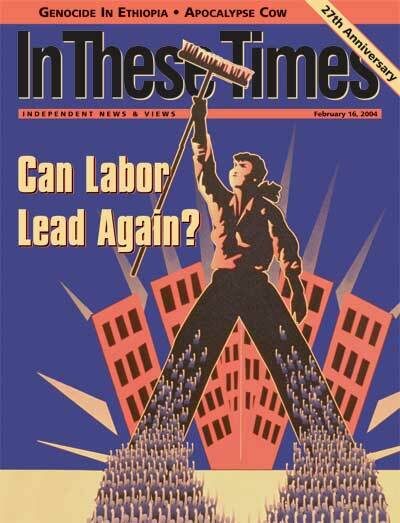
This is a critical year for the labor movement as it attempts to revitalize and transform itself into a national progressive political force. The outcome of several major organizing campaigns and unions’ impact on the end result of the fall elections will determine the course of economic and social justice for generations to come. Yet with much of the discussion focused on strategies for union growth and political mobilization, it is worthwhile to discuss what has plagued the American labor movement throughout its history: recognizing the multiple identities and injustices of its members and potential members.
The multiple social, political and communal networks in which workers are embedded on the shop floor and outside the workplace are all shaped by race, gender and nationality, and are critical resources that unions can tap. For example, successful HERE locals in Chicago (Local 1) and New Haven, Connecticut (Yale Unions), have used their members’ and leaders’ social networks—including churches and community organizations—to enhance their struggles and build enduring alliances.
We know that community-labor coalitions are and will be a vital resource in labor’s survival and revitalization. For instance, religious institutions play a crucial political role in communities of color by providing moral, social and political support and resources in their members’ daily lives, and in many campaigns for justice. It’s one thing for a union president to approach a minister to ask for help; it’s quite another when a member or members of a union approach their own minister and congregation and ask for help in their fight for justice. By recognizing the multiple identities of their memberships during an organizing campaign, unions can expand their struggles from being a fight between the union and employer to being a fight between an entire community and an employer.
The Immigrant Workers Freedom Ride (IWFR) last fall indicates that the more progressive unions such as HERE, SEIU, UNITE and the United Farm Workers have studied their labor history. The fact is, workers don’t check their other identities and social positions at the shop floor door; they are people of color, women, immigrants, gays and workers on the shop floor, at home, at church, at the store, and on all the streets in between. Yet a dominant ideology within the labor movement continues to minimize and subsume workers’ other political identities, despite the numerous alternative models of unionism displayed by black, immigrant, female and gay workers throughout labor history.
The IWFR—note it was not simply the “workers freedom ride”—demonstrates that unions are acknowledging the multiple vulnerable positions many workers inhabit, because the bosses surely will, as they always have. Employers such as Wal-Mart continue to use the time-tested strategies of racism, sexism and fear to exploit and divide workers, thwarting unionization campaigns. Dr. Martin Luther King, Jr. illustrated the interconnections between racial and economic injustices in a 1961 speech to the AFL-CIO, “…the labor-hater and labor-baiter is virtually always a twin-headed creature spewing anti-Negro epithets from one mouth and anti-labor propaganda from the other mouth.”
A strategy that recognizes the many identities of workers can make a tremendous difference to organizing and contract campaigns. Realizing that workers bring a variety of ethnic, racial, gender and sexual backgrounds with them does not have to be divisive within the unifying framework of a union. Unions should not mimic corporate America’s dumbed-down “sensitivity trainings” and adopt a superficial celebration of “differences.” Instead, there are three lessons we can draw when unions take seriously the maxim “an injury to one is an injury to all”.
The multiple social, political and communal networks in which workers are embedded on the shop floor and outside the workplace are all shaped by race, gender and nationality, and are critical resources that unions can tap. For example, successful HERE locals in Chicago (Local 1) and New Haven, Connecticut (Yale Unions), have used their members’ and leaders’ social networks—including churches and community organizations—to enhance their struggles and build enduring alliances.
We know that community-labor coalitions are and will be a vital resource in labor’s survival and revitalization. For instance, religious institutions play a crucial political role in communities of color by providing moral, social and political support and resources in their members’ daily lives, and in many campaigns for justice. It’s one thing for a union president to approach a minister to ask for help; it’s quite another when a member or members of a union approach their own minister and congregation and ask for help in their fight for justice. By recognizing the multiple identities of their memberships during an organizing campaign, unions can expand their struggles from being a fight between the union and employer to being a fight between an entire community and an employer.
The Immigrant Workers Freedom Ride (IWFR) last fall indicates that the more progressive unions such as HERE, SEIU, UNITE and the United Farm Workers have studied their labor history. The fact is, workers don’t check their other identities and social positions at the shop floor door; they are people of color, women, immigrants, gays and workers on the shop floor, at home, at church, at the store, and on all the streets in between. Yet a dominant ideology within the labor movement continues to minimize and subsume workers’ other political identities, despite the numerous alternative models of unionism displayed by black, immigrant, female and gay workers throughout labor history.
The IWFR—note it was not simply the “workers freedom ride”—demonstrates that unions are acknowledging the multiple vulnerable positions many workers inhabit, because the bosses surely will, as they always have. Employers such as Wal-Mart continue to use the time-tested strategies of racism, sexism and fear to exploit and divide workers, thwarting unionization campaigns. Dr. Martin Luther King, Jr. illustrated the interconnections between racial and economic injustices in a 1961 speech to the AFL-CIO, “…the labor-hater and labor-baiter is virtually always a twin-headed creature spewing anti-Negro epithets from one mouth and anti-labor propaganda from the other mouth.”
A strategy that recognizes the many identities of workers can make a tremendous difference to organizing and contract campaigns. Realizing that workers bring a variety of ethnic, racial, gender and sexual backgrounds with them does not have to be divisive within the unifying framework of a union. Unions should not mimic corporate America’s dumbed-down “sensitivity trainings” and adopt a superficial celebration of “differences.” Instead, there are three lessons we can draw when unions take seriously the maxim “an injury to one is an injury to all”.
- First, and most important, recognizing the multiple identities of workers—and the varied and overlapping injustices the face as a result—brings valuable and often underused resources to a union.
- Second, when the tough issues of racism, nativism or sexism are addressed internally and head-on, it can increase strength and solidarity. Doing so allows unions to put these issues on the table before the boss uses them as ways to divide and conquer.
- And third, the most innovative and successful models of unionism, especially during periods of resurgence and rejuvenation, historically involved the active recruitment of previously excluded workers and the infusion of these workers’ other solidarities—race, ethnicity, gender, religion and even neighborhood—into the movement.
Dorian T. Warren is a Ph.D. candidate in political science at Yale University and a member of the steering committee of the Chicago Center for Working Class Studies.





